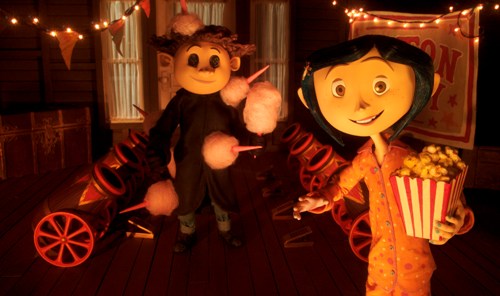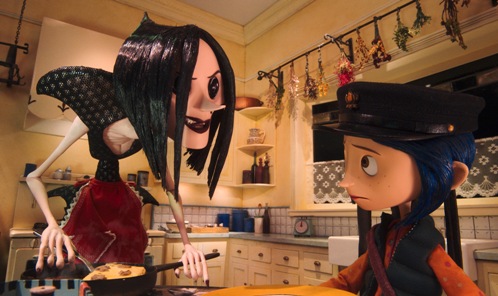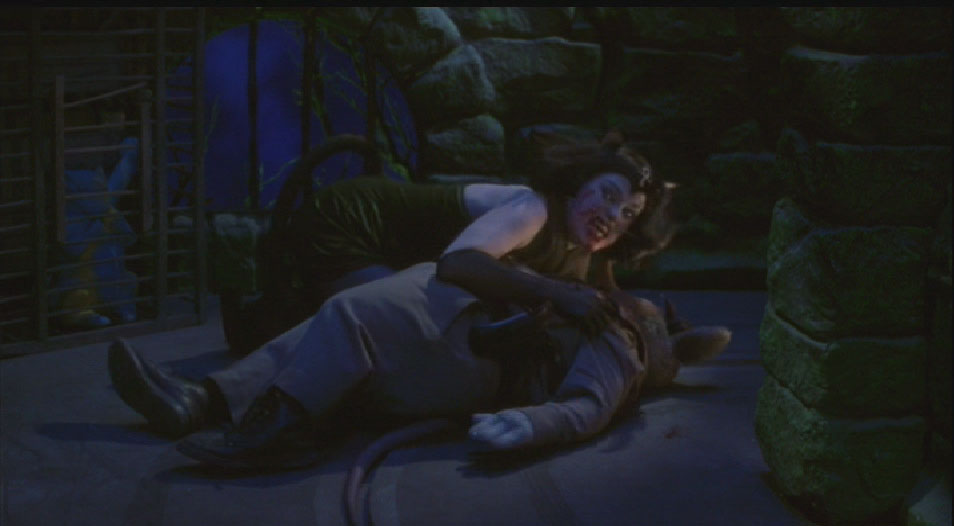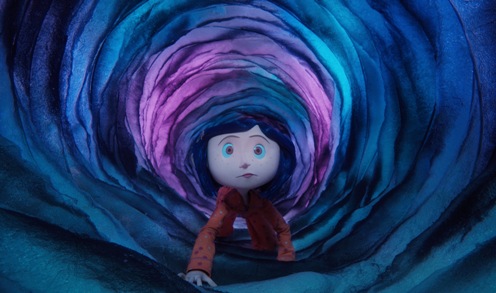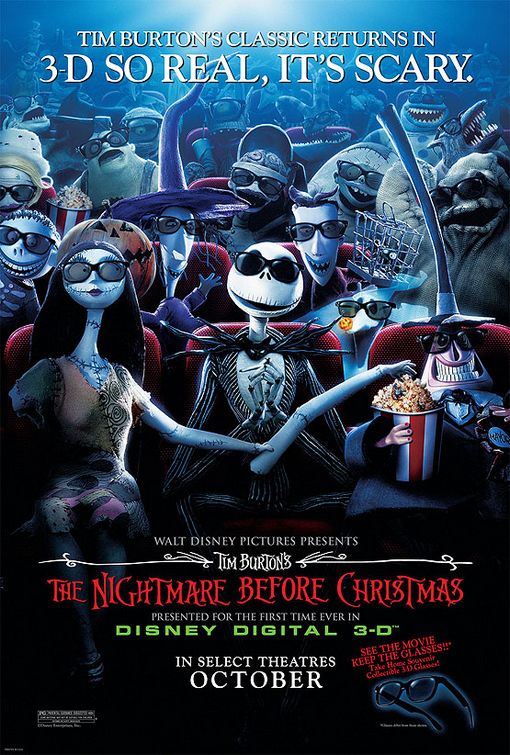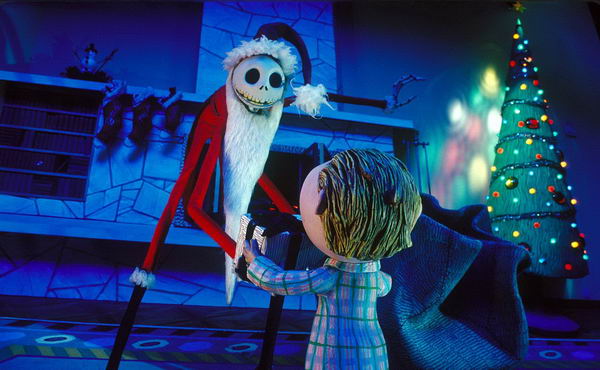
New Blu-ray release offers improved picture and sound quality but little in the way of additional bonus features.
Riding on the delightfully cobwebbed coat-tails of Tim Burton’s THE NIGHTMARE BEFORE CHRISTMAS, poor JAMES AND THE GIANT PEACH was probably predestined to be a disappointment, for what film could possibly live up to that level of expectation? Even with the NIGHTMARE team of director Henry Selick and producers Tim Burton and Denise Di Novi reassembled, it was unlikely that the mad scientist’s lightening would animate a new creation of equal quality.
Sad to say, JAMES AND THE GIANT PEACH not only failed to meet unrealistic expectations; it was also an under achiever on its own terms. Although a technical marvel of production design, stop-motion animation, and other special effects techniques, the film is felled by annoying characters, flat songs, and a limp screenplay straining to pad a slim story out to feature length. The bottom line is that it lacked the magic that made THE NIGHTMARE BEFORE CHRISTMAS a joy to watch again and again.
The reason for this becomes clear during the fist act’s live action sequences. The notion that young James became an orphan when a rhinoceros gobbled up his parents is awkwardly handled by depicting the rampaging rhino as a cloud. After that, the film finds its tone; unfortunately, that tone can best be summed up as “annoying.” The live-action scenes of James being mistreated by his aunts, Spiker and Sponge (Joanna Lumley and Miram Margoylyes), are achingly unfunny despite the obvious attempt to portray the campy pair as vile villains of the black comedy variety.
 When James escapes from Spiker and Sponge in the giant peach of the title, the film shifts to stop-motion. The transition is smoothly handled, adding an extra level of fantasy to the material. Unfortunately, James’s new friends, a small group of insects, turn out to be almost as annoying as his aunts, especially the brash-talking centipede voiced by Richard Dreyfuss. James himself is a fairly non-descript character, whom the others praise for his cleverness, even when he is doing only what is obvious. His big scene, confronting the rhinoceros that gobbled his parents, plays like a hollow victory, because we can see that he is merely yelling at a dissipating cloud – not the most courageous act of heroism ever recorded on camera.
When James escapes from Spiker and Sponge in the giant peach of the title, the film shifts to stop-motion. The transition is smoothly handled, adding an extra level of fantasy to the material. Unfortunately, James’s new friends, a small group of insects, turn out to be almost as annoying as his aunts, especially the brash-talking centipede voiced by Richard Dreyfuss. James himself is a fairly non-descript character, whom the others praise for his cleverness, even when he is doing only what is obvious. His big scene, confronting the rhinoceros that gobbled his parents, plays like a hollow victory, because we can see that he is merely yelling at a dissipating cloud – not the most courageous act of heroism ever recorded on camera.
As if sensing that the third act needs something more, the script throws in a ridiculous scene in New York, where the peach lands on top of the Empire State Building – only for James to be met by his aunts, who have apparently driven beneath the Atlantic ocean in their beat-up old car! What is clearly meant to be taken as a hysterically surreal moment is too obviously an awkward writer’s device, providing an opportunity for the aunt’s to get their come-uppance at the hands of James’s insect friends. But this is par for the course: the entire script feels like an episodic grab bag, with occasional threats and obstacles showing up randomly just to give the characters something to do.
JAMES AND THE GIANT PEACH deserves credit for attempting to translate the wicked, semi-scary tone of Roald Dahl’s children’s book to the screen; unfortunately, the attempt fails, creating an odd mix of the whimsical and the weird that feels less like an audacious conflation of contradictory elements than an awkward jumble, a point too often underlined by Randy Newman’s score, which becomes the audio equivalent of someone repeatedly elbowing you in the ribs to remind you how wonderful and amazing all of this is supposed to be. Perhaps Dahl’s combination of childhood fantasies and fears is difficult to realize on screen, but THE WITCHES (1990), directed by Nicolas Roeg, proved that it can be done without diluting either element.
BLU-RAY & DVD DETAILS

Disney’s new special edition 2-disc combo pack (Street Date: August 3, 2010) includes JAMES AND THE GIANT PEACH on both Blu-ray and DVD. The picture quality on both is quite nice. Of course, the high-def Blu-ray transfer is superior; however, the picture quality of the 1996 film is not up to the standards of more recent films when transferred to the high-def medium. The result looks very good, but it does not pop off the screen in the same way that the Blu-ray discs own menu features do.
Unfortunately, both discs feature what Walt Disney Pictures likes to call “Fast Play,” which is touted as an “easy start up without using a remote control.” What this means is that, instead of going immediately to the main menu, the disc immediately starts playing promos and trailers for other Disney products, through which you must chapter stop to get to the film you actually thought you were purchasing. This is not so much a problem with the DVD, but it is annoying with the Blu-ray, which has a longer loading time – god forbid you should accidentally push the Eject button midway through the movie, and then have to go through the whole loading process again.
Both discs port over bonus features from the 2000 special edition DVD release: a making-of featurette (actually a promotional puff piece); a trailer; a Randy Newman music video; and several extensive photo galleries, divided up into Concept Art, Puppets, Behind the Scenes, and Live Action. In addition, the DVD includes a trailer for THE NIGHTMARE BEFORE CHRISTMAS, which is not available on the Blu-ray.
The only new feature actually on the Blu-ray disc is a videogame that allows you to earn points by manipulating a rhinoceros to head-butt Aunts Spiker and Sponge. It’s amusing for a minute or two; little kids may enjoy it a while longer. The Blu-ray disc is also BD-Live enabled, which allows you to access more material via an Internet connection to your Blu-ray player.
NOTE: According to the 96% rating at Rotten Tomatoes, my view of JAMES AND THE GIANT PEACH is clearly in the minority. You can get a second opinion on the film, courtesy of Mike Lyons, by clicking here.
[serialposts]
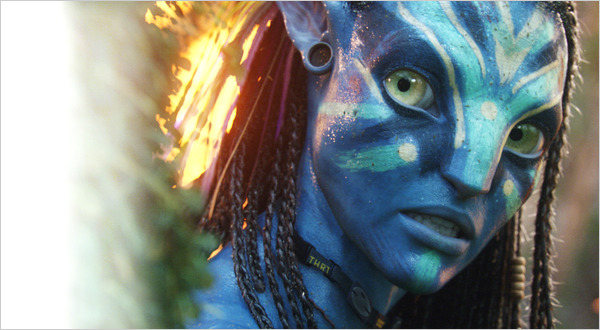


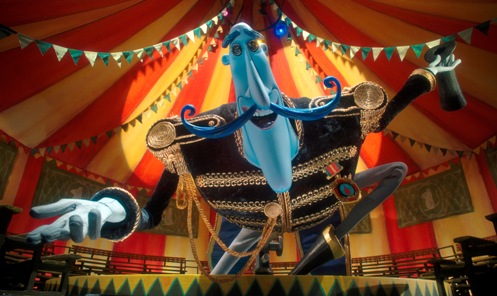
 Whether you go through the looking glass, down the rabbit hole, over the rainbow, or into the labyrinth, you are bound to encounter wonders beyond your imagination, sights and sounds that impress the senses and embed themselves upon the brain with all the enchantment of a beautiful dream, but somewhere in our minds we know that dreams are not real and that if something seems too good to be true, inevitably it is. This is the simple lesson of CORALINE, the amazing new stop-motion film from Henry Selick (director of Tim Burton’s
Whether you go through the looking glass, down the rabbit hole, over the rainbow, or into the labyrinth, you are bound to encounter wonders beyond your imagination, sights and sounds that impress the senses and embed themselves upon the brain with all the enchantment of a beautiful dream, but somewhere in our minds we know that dreams are not real and that if something seems too good to be true, inevitably it is. This is the simple lesson of CORALINE, the amazing new stop-motion film from Henry Selick (director of Tim Burton’s 